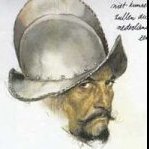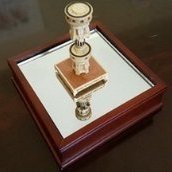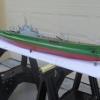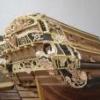MORE HANDBOOKS ARE ON THEIR WAY! We will let you know when they get here.
×
-
Posts
3,867 -
Joined
-
Last visited
Reputation Activity
-
 KeithAug got a reaction from KORTES in Altair 1931 by KeithAug - FINISHED - Scale 1:32 - schooner
KeithAug got a reaction from KORTES in Altair 1931 by KeithAug - FINISHED - Scale 1:32 - schooner
More deck planking:-
I made a start on the planking which follows the contour of the deck edge. As explained previously these planks are much narrower. I made the planks .108 inch wide x 10 inch long which is 3.5 inch by 26 foot at full size.
It's probably worth posting a few images of the real thing at this point:-
I wanted the deck to be representative of the real thing but accepted that absolute accuracy wasn't quite achievable.
So here are a few images of progress to date:-
I was progressing well until my helper arrived and demanded some exercise!
-
 KeithAug got a reaction from KORTES in Altair 1931 by KeithAug - FINISHED - Scale 1:32 - schooner
KeithAug got a reaction from KORTES in Altair 1931 by KeithAug - FINISHED - Scale 1:32 - schooner
Starting the deck planking:-
I decided to make the deck planking .045 inch thick. This is thicker than the previous build (Endeavour) which was circa .030 thick. The additional thickness should make the caulking easier.
The mahogany deck edge planks were glued in place taking great care to make sure they were equidistant from the centre line. It's really easy for the deck planking to become unsymmetrical about the centre line and this can look pretty bad.
I wanted something that looked like teak for the deck planks and the nearest thing I had were slats recovered from a broken wooden venetian blind. The deck planking is a bit unusual in design in that the centre line planks on the fore deck are greater in number than over the remainder of the deck. The centre line planks are also wider than the other deck planks. I decided to go for a width of 0.188 inch for the centre line planks which equates to a scale width of 6 inch.
I decided to caulk between the planks using .008 inch thick black card. This equates to a thickness of 1/4 inch which is about right fro deck caulking.
The caulking was accurately cut into strips .045 inch wide using a set up on the mill. This consists of a MDF board clamped to the mill table with a steel bar clamped into the chuck to form a guide. With the card taped to the MDF the steel bar is positioned a couple of thou above the card and this forms the back stop for the set square. The mill table is then indexed in .045 inch steps and at each step a strip is cut from the card using a craft knife.
The centre line planks are then glued in place - making sure they are symmetrical about the centre line. In the photos below you can see one of the caulking strips laid on the deck and the tail of one of the installed strips.
The centre line planks are now complete but at this stage not sanded.
The caulking effect looks pretty good.
-
 KeithAug got a reaction from Tecko in Altair 1931 by KeithAug - FINISHED - Scale 1:32 - schooner
KeithAug got a reaction from Tecko in Altair 1931 by KeithAug - FINISHED - Scale 1:32 - schooner
Thanks Pete
I stayed at Coeur d'Alene once on the way to visit the Scablands and Glacier NP. A nice part of the world.
Progress of a different kind!
Having glued the deck in place and strengthened the areas unsupported by frames (g clamps in photo), I thought I had better take stock.
For the deck edge planks I needed to cut .040" x .130" mahogany strips from a 40"x12"x7/8" former table top. This involved planing and sawing operations on my full size wood machines as well as sawing on the Byrnes saw using TCT and slitting saw blades. Multiple operations and setting on different machines is always something I am inclined to put off. This instance was no different and I found myself looking for something else to do. My diversion project started out as cleaning up the workshop (photos attached) but very quickly expanded into clearing out my tool draws. I set myself the challenge of throwing out all the tools that I couldn't remember having used in the last 20 years. It was quite a haul but I failed with a few items that I thought might come in useful some day!!! They will probably be thrown out by the kids when they come to sort out my affairs in another 20 years time. The up side though is that I discovered stuff that would be useful if I had only remembered that I had it.
Having exhausted all my diversionary jobs I made the 6 deck edge planks, yawn!
I have a question for all you experienced posters. I see that when you sign off your posts you frequently attach reference to all your past, ongoing an future builds. I assume that you don't type this stuff out every time and that somehow you have set it up automatically. How do you do this please?
Keith
-
 KeithAug got a reaction from Tecko in Altair 1931 by KeithAug - FINISHED - Scale 1:32 - schooner
KeithAug got a reaction from Tecko in Altair 1931 by KeithAug - FINISHED - Scale 1:32 - schooner
The sub deck:-
The various apertures for the chart house, skylights, hatches etc were cut out using a craft knife before
hacking the deck roughly to shape using the jigsaw. I left about 1/8 inch all round for final adjustment. A prolonged process of plane a bit, pin in place, check, remove, plane a bit more then ensued until I was happy with the fit. With the sub deck in place I drilled through it into the frames at multiple positions. As explained earlier the deck is concave longitudinally and convex across the beam. Some force is needed to hold the shape while gluing and the multiple holes will take the holding pins during in the gluing operation. The photos show the deck temporarily in place.
I mentioned in a previous post that the frames were spaced randomly on the plan and I had thought that this was for some greater purpose - to be revealed later in the build. It would have been sensible if the frames had been organised around the deck apertures but this wasn't the case - so the mystery of the random spacing continues.
With the deck temporarily in pace I marked the aperture positions on the frames and then removed the deck and cut the frames away with a razor saw. In one position I reinstalled an offset deck beam to support the deck. In two other positions I intend reinforcing the ply to compensate for local removal of the frames. I decided to install 2 oak blocks threaded and tapped (M8) to take the bolts for later installation of plank to handle the hull inverted for the 2nd planking operation. I find oak takes a thread well and shows no tendency to strip.
Finally I marked the edge of the deck on the line where the mahogany deck planks meet the teak planks.
Nothing to do now but glue the deck.
-
 KeithAug got a reaction from KORTES in Altair 1931 by KeithAug - FINISHED - Scale 1:32 - schooner
KeithAug got a reaction from KORTES in Altair 1931 by KeithAug - FINISHED - Scale 1:32 - schooner
Removal of up stands and a start on the deck:-
I had part cut the frames at deck level so removal of the up-stands wasn't a difficult process. I started by hand cutting but soon abandoned this in favour of a recently acquired multi tool fitted with a plunge blade. It worked a treat and I wonder why I hadn't bought one ages ago. I sanded the frames until I was comfortable with the deck profile which is concave bow to stern and convex across the beam. I used one of the left over planks laid across the frames to test the deck shape.
I decided to make the sub deck from 1/16 inch ply. Having cut a rectangular piece large enough to cover the hull I laid one of the long edges on the centre line of the hull and marked the position of the frames. I then drew the frame positions across the ply.
Having established the frame positions I used dividers to transfer the shapes of the deck cut outs from the plans on to the plywood.
Again using dividers I transferred the width of the hull on to the plywood at each frame position. The frames width dimensions were taken from the actual hull and not the plans.
I then used pins to give reference points against which a plank could be bent enabling the deck edge profile to be marked.
Having marked the deck profile I temporarily attached the plywood to the hull along the centre line.
I then marked the hull profile on the underside of the plywood using the hull as a template - thus checking the accuracy of the deck profile previously drawn. All was well.
Keith
-
 KeithAug got a reaction from Nirvana in Altair 1931 by KeithAug - FINISHED - Scale 1:32 - schooner
KeithAug got a reaction from Nirvana in Altair 1931 by KeithAug - FINISHED - Scale 1:32 - schooner
A little more progress..........
Having marked the waterline on the hull I realised my previous sequence had missed the vital step of making a building cradle. I had a look around the workshop and came across the discarded cradle from Endeavour. The fuller hull of Altair was fortuitous as a few quick cuts with the jigsaw transformed the cradle into one suitable for this build. (I used the frame templates from earlier to get the correct cradle profile).
With the hull finally the correct way up I set about the task of removing the building board. You may recall not all the frames were glued to the board and I had marked the glued frames so I knew where to cut.
While cutting away the building board I mused on the various removal stages and decided to name them for fun:-
1 THE AIRCRAFT CARRIER STAGE. (Illustrious class I think)
2 SAWING THE FAT LADY IN HALF STAGE. (Taking care not to get carried away)
3 THE CHINESE JUNK PHASE.
4 THE GALLEON PHASE (Forecastle still to be built)
Having removed all of the building board I started on the frames - the aft most frame removed to deck level.
-
 KeithAug got a reaction from Nirvana in Altair 1931 by KeithAug - FINISHED - Scale 1:32 - schooner
KeithAug got a reaction from Nirvana in Altair 1931 by KeithAug - FINISHED - Scale 1:32 - schooner
Tom,
Yes hand tools only. Power tools were limited to a mini craft drill, a Black and Decker hand drill and a soldering iron. I didn't even have a power sander. I managed to make a lot of the circular parts out of nesting brass tubes - I got a huge bag of offcuts from a local model shop. What little turning I needed to do was done with the black and decker and various files. I bought the frigates props / shafts / rudders but apart from that all the other metalwork was hand made. That said I don't think I would ever want to do without a lathe and mill now. Both were bought 4 years ago and I rely on them a lot.
I did buy planking pre cut - but this was an expensive option and now I cut my own - as illustrated earlier in my build log.
I have now adopted a policy of if If I need a power tool I buy it or make it, life as a result is much easier.
Tom / Jorgen
Thank you for your kind comments.
-
 KeithAug got a reaction from Piet in La Salamandre by tadheus - 1:24
KeithAug got a reaction from Piet in La Salamandre by tadheus - 1:24
Tadheus
lovely work and very realistic.
-
 KeithAug got a reaction from mtaylor in Altair 1931 by KeithAug - FINISHED - Scale 1:32 - schooner
KeithAug got a reaction from mtaylor in Altair 1931 by KeithAug - FINISHED - Scale 1:32 - schooner
Tom,
Yes hand tools only. Power tools were limited to a mini craft drill, a Black and Decker hand drill and a soldering iron. I didn't even have a power sander. I managed to make a lot of the circular parts out of nesting brass tubes - I got a huge bag of offcuts from a local model shop. What little turning I needed to do was done with the black and decker and various files. I bought the frigates props / shafts / rudders but apart from that all the other metalwork was hand made. That said I don't think I would ever want to do without a lathe and mill now. Both were bought 4 years ago and I rely on them a lot.
I did buy planking pre cut - but this was an expensive option and now I cut my own - as illustrated earlier in my build log.
I have now adopted a policy of if If I need a power tool I buy it or make it, life as a result is much easier.
Tom / Jorgen
Thank you for your kind comments.
-
 KeithAug got a reaction from Zarkon in Altair 1931 by KeithAug - FINISHED - Scale 1:32 - schooner
KeithAug got a reaction from Zarkon in Altair 1931 by KeithAug - FINISHED - Scale 1:32 - schooner
Hi Jorgen
Thanks of the feedback.
You clearly have skill - with practice you will be soon be achieving the quality of work you aspire to.
For many years I had relatively simple tools - here are a couple of models I produced with only hand tools and a model makers hand drill.
The tug was my first model - a kit.
The frigate was my second - scratch build
-
 KeithAug got a reaction from cabrapente in Altair 1931 by KeithAug - FINISHED - Scale 1:32 - schooner
KeithAug got a reaction from cabrapente in Altair 1931 by KeithAug - FINISHED - Scale 1:32 - schooner
Appart from doing other stuff I have found a bit of time to progress the planking.
On my last post I had started attaching the taper planks.
I progressed the taper planks which started having the desired effect of filling the area of maximum beam while limiting the degree of bending in the stiff direction of the plank. I also planked the end of the keel in front of the rudder position.
You may remember form a previous post I had marked the hull and identified where i would get to if I had pressed on with parallel planking (red line). Also you may recall that i wanted to end up at the black line. The plan worked reasonably well as illustrated by the photographs.
I did have to do a fairly complicated adjustment by letting in a fillet pieces at one position on each side. See 4th plank down on the next photo.
Much of the tricky planking is now done and most of the remaining planks will parallel, supplemented by finely tapered wedges to fill out the rear of keel.
-
 KeithAug got a reaction from KORTES in Altair 1931 by KeithAug - FINISHED - Scale 1:32 - schooner
KeithAug got a reaction from KORTES in Altair 1931 by KeithAug - FINISHED - Scale 1:32 - schooner
So here is my solution to creating uniform shallow taper planks.
I have a home made thickness sander attachment for my milling machine as follows:-
The oak plank up-stand is pivoted about the end towards the front of the photo with coarse adjustment being achieved by the screw adjuster to the right of the oak plank. Fine adjustment down to thousands of an inch is achieved by using the mill table adjustment. It all works very well for sanding parallel planks.
I realised I could use the thickness sander to taper sand by setting the oak plank at the desired angle and sticking the workpiece to the the oak plank using double sided tape. Then by traversing the workpiece past the sanding drum (using the mill table) I was able taper sand the workpiece. I should explain that the final planks were going to be slit from the tapered workpiece using the table saw.
I wanted a taper of about 1/3 of a degree over the 15 inch length of the workpiece - which equates to the narrow end being about 1/2 the thickness of the wide end.
This photo shows the tapered workpiece laid alongside a parallel workpiece.
And the dimensions achieved.
The final photos show the tapered planks being attached to the hull.
-
 KeithAug got a reaction from KORTES in Altair 1931 by KeithAug - FINISHED - Scale 1:32 - schooner
KeithAug got a reaction from KORTES in Altair 1931 by KeithAug - FINISHED - Scale 1:32 - schooner
Thank you Mark and John for your supportive comments.
I have been progressed a little with the hull 2nd planking.
I find it is quite easy to over think the planking and I prefer to just get on with it and let the planks tell me when they are finding it difficult to follow one another. In this case this started to occur after the 8th / 9th parallel plank. At this stage I marked off the hull as though I would continue with parallel planks. This produced the red line on the photo. I concluded that planking to the red line (even if it was possible) would produce a quite unrealistic planking effect on the keel so I drew the black line to represent where I wanted the planks to fall.
Measuring the space between the lines gave me an indication of how much "extra" planking width I would have to find at the waist - .495 inch (about 3 plank widths) in this case.
I now need a cunning plan for manufacturing a reasonable number of accurately formed taper planks. I feel a bit of experimenting coming on.
-
 KeithAug got a reaction from KORTES in Altair 1931 by KeithAug - FINISHED - Scale 1:32 - schooner
KeithAug got a reaction from KORTES in Altair 1931 by KeithAug - FINISHED - Scale 1:32 - schooner
Before getting too far into the 2nd planking I needed to drill the holes to take the hawse pipes (one on either side of the bow). These are at a compound angle flaring outward and forward as they descend through hull. Three options were available for drilling as follows:-
1, Drill from the deck and exit the drill through the hull.
2, Drill from the hull and exit the drill through the deck.
3, Drill half way from the deck and half way from the hull - meeting in the middle!!!!!
Option 3 would appear to be bonkers however............
Options 1 and 2 have the potential for the exit holes to be out of position - which I thought would look awful. So option 3 it was!
I marked guide lines on the hull at the correct angle and used my hand held drill carefully judging the correct angle. By using a smaller drill than the final hole size and enlarging it with a circular needle file I did manage to make the holes join up. I finished with a 0.16" (4mm reamer to clean up the holes so the hawse pipe would fit snugly.
-
 KeithAug got a reaction from KORTES in Altair 1931 by KeithAug - FINISHED - Scale 1:32 - schooner
KeithAug got a reaction from KORTES in Altair 1931 by KeithAug - FINISHED - Scale 1:32 - schooner
Having completed the ribs I decided to attach the 3rd of the profiled 1/32 inch (actually .036') plywood layers that went to create the profile at the upper edge of the hull.
With this in place it was time to commence the second mahogany planking. This was cut from the old table top mentioned earlier. The planks were .036" x .180" x 15 inch. The first plank went on butting up to the step created by the 3rd plywood layer.
the bulwarks have turned out well and are very solid - testament to the strength of layers of laminated plywood.
3 layers of planking now in place.
so far, so good.
I should probably explain at this stage that the plywood will be painted white while and I am considering leaving the mahogany visible - probably satin poly.
-
 KeithAug got a reaction from KORTES in Altair 1931 by KeithAug - FINISHED - Scale 1:32 - schooner
KeithAug got a reaction from KORTES in Altair 1931 by KeithAug - FINISHED - Scale 1:32 - schooner
I managed to get enough time to complete the ribs. I was struggling a bit to see the laser line until I realised the batteries were about 10 years old. the new ones improved matters greatly.........
With all the ribs attached I used a flexible dowel (zero kerf) pull saw to trim them back to the height of the bulwark.
-
 KeithAug got a reaction from KORTES in Altair 1931 by KeithAug - FINISHED - Scale 1:32 - schooner
KeithAug got a reaction from KORTES in Altair 1931 by KeithAug - FINISHED - Scale 1:32 - schooner
I got a stay of execution on the decorating so managed to do a bit more.
The frames on the model plan don't match the frame positions on the original yacht. The frame positions behind the bulwarks therefore have to simulated by gluing on false ribs.
The ribs do however need to be truly vertical which is a bit difficult when the deck bows from stem to stern with a pronounced rise at the stem. Obviously taking a reference from the deck wasn't an option. I decided the reference had to be taken from the workbench but it wasn't immediately obvious how I would transfer a vertical line from the bench to the inside of the bulwark.
A bit of thinking prompted the following solution.
The key component is a christmas stocking quality laser line level. I mounted it on a v block with a vertical post clamped in place to hold the laser. With a bit of shimming I adjusted the laser to cast a vertical line on the wall. This was then used to transfer vertical lines on to the inside of the bulwarks (using the laser line to as the guide for drawing vertical pencil lines)
The horizontal positions of the ribs were transferred to the deck using a template.
The ribs were cut from .150" x .150" mahogany plank (cut using the slitting saw). Each one had to be shaped on the disc sander to fit the changing profiles of the bulwarks / deck.
So far so good!
-
 KeithAug got a reaction from KORTES in Altair 1931 by KeithAug - FINISHED - Scale 1:32 - schooner
KeithAug got a reaction from KORTES in Altair 1931 by KeithAug - FINISHED - Scale 1:32 - schooner
Praying for Rain!
Its been some time since my last post. My dear daughter purchased a flat in London in a property built in 1880. It needs a degree of refurbishment and I have been appointed to the post of chief joiner/painter. With that and the garden bursting into spring life I have had little time for my favourite pastime. However today I was at home and thankfully it rained so the yacht took a minor step forward.
I needed to mahogany plank the inside of the bulwarks to represent the detail of the original. See photo
I cut the planks 12"x0.2"x.032" on the circular saw using a .032 thick zero kerf slitting saw blade. The finish was almost polished!
I needed 10 planks to complete the whole process.
I used paper to create the template for the stern.
Having had my modelling fix I now return to house refurbishment - yawn!!!!
-
 KeithAug got a reaction from KORTES in Altair 1931 by KeithAug - FINISHED - Scale 1:32 - schooner
KeithAug got a reaction from KORTES in Altair 1931 by KeithAug - FINISHED - Scale 1:32 - schooner
Bulwarks continued.
It feels like I am taking a long time over this. Accurately shaping the 6 bulwark pieces took a lot of time but now it is done.
The the middle of the 3 layers went on first and fortunately it went on well.
The inner layer went on next - thus creating the first sculpture line on the hull.
The bow where the bow sprit passes through is very heavily built on Altair and I wanted to reproduce this on the model.
The transom also has a fairly subtle shape which I will try to reproduce.
But first I needed to get the stern bulwark in place.
And that is how far I have got at present.
-
 KeithAug got a reaction from KORTES in Altair 1931 by KeithAug - FINISHED - Scale 1:32 - schooner
KeithAug got a reaction from KORTES in Altair 1931 by KeithAug - FINISHED - Scale 1:32 - schooner
Bulwarks!!
So I finally got round to making a start on the Bulwarks. From earlier posts it is apparent that I was approaching this with some trepidation. The sculpturing of the hull on the outside of the bulwarks (see photo) is something I have not done before and I tend to explore options in my head for weeks before attempting something like this. In the end I have to get on with it before I go mad.
I had done a bit of preplanning in that I had left the upper edge of the hull un-planked so that the recess could take the lower edge of the bulwark.
To create the sculpturing the bulwark is going to be laid up in 3 layers of .032 inch ply. The middle of the 3 layers is going on first and fits in the un-planked recess. This middle layer will form the upper sculptured line and the outer layer the lower sculptured line. A bit difficult to explain but I'm sure it will become clear as I work through the process over the coming days.
Anyway the starting operation was to make up a cardboard template to get an accurate representation of the hull recess.
The shape of the bulwark pieces is quite complex and it took a lot of assembling, removing, sanding etc etc before I was happy with the shape. After the best part of a days work I now have 2 parts almost complete and temporarily pinned in place.
Only 4 more pieces to go.
-
 KeithAug got a reaction from KORTES in Altair 1931 by KeithAug - FINISHED - Scale 1:32 - schooner
KeithAug got a reaction from KORTES in Altair 1931 by KeithAug - FINISHED - Scale 1:32 - schooner
I'm still watching varnish dry. The second and third coats have gone on and each dried in 10 hours. The 24 hours drying of the first coat must have had something to do with absorption of the varnish into the wood. Anyway it gave me time to finish off the prop shaft. I still have to make the "A" frame for supporting the rear bearing.
-
 KeithAug got a reaction from KORTES in Altair 1931 by KeithAug - FINISHED - Scale 1:32 - schooner
KeithAug got a reaction from KORTES in Altair 1931 by KeithAug - FINISHED - Scale 1:32 - schooner
Today I had to find something to amuse myself as watching varnish dry isn't a very stimuating pass time (it has dried finally after 24 hours).
I thought I would have a go at making the propeller. I have not made one before and the fall back option was going to be to buy one. I don't however like buying fittings as it always feels like cheating.
This is what I did.
Firstly to make the blades I cut 3 identical strips of brass .040 inch thick. The 3 strips were fastened together using double sided tape as I intended cutting out all 3 blades at the same time. A paper template was fastened to the brass strips again using double sided tape . Confidence / experiences was low so I marked out 6 blades. The pin in one of the photo's gives an idea of scale.
I din't need the reserve set of 3 blades as the first lot turned out ok. The small peg at the bottom of each blade was to locate / fasten them in the hub.
The hub was turned on the lathe and 3 equi-spaced holes were drilled around the circumference to take the pegs on the blade. Each blade was given a slight curvature by bending it around a bar - using the vice to apply the pressure. The whole lot was then assembled and soldered together.
-
 KeithAug got a reaction from KORTES in Altair 1931 by KeithAug - FINISHED - Scale 1:32 - schooner
KeithAug got a reaction from KORTES in Altair 1931 by KeithAug - FINISHED - Scale 1:32 - schooner
I have now completed the 1st planking on both sides of the hull - so far so good. Although I had thought that I would revert to narrower planks at some stage, in the end I found it to be unnecessary.
Before sanding I roughly drew pencil lines on the hull to act a sanding guide. Sanding to remove the pencil lines enables me to achieve a smooth finish while avoiding sanding through of the planks.
I have completed the sanding of one side - it took about an hour and a half using coarse grit emery cloth on a cork block.
The bow and stern shots show the before and after.
I have abandoned sanding - family are arriving soon and they plan to stay for at least a week. Boat building has to be curtailed for some time.
-
 KeithAug got a reaction from KORTES in Altair 1931 by KeithAug - FINISHED - Scale 1:32 - schooner
KeithAug got a reaction from KORTES in Altair 1931 by KeithAug - FINISHED - Scale 1:32 - schooner
Hi Pete, John and HArtmut. Thanks for your encouragement on my planking efforts.
Its time for a progress update.
I thought I would get the difficult bit out of the way and continue with the tapered planks around the hulls belly. The photos are fairly self explanatory so I'll cut down on dialogue.
The final closure plank is always the most tricky to get right and I have developed the "black finger method" to make it easier.
I start by loosely laying a piece of printer paper over the hole to be filled. Running a finger over the paper above the hole creates an indent which accurately represents the shape of the closure plank.
I find it really hard to see the profile of the plank once the paper is removed so I shave some graphite from pencil and rub my finger in it.
I then rub my finger over the paper and this gives me a very visible profile for the closure plank.
I then cut out the profile to make a template.
The template is transferred to a plank and glued in place using a glue stick.
The plank is cut out, finish sanded to fit and then glued in place.
Now I can proceed with the easier task of planking the keel.
-
 KeithAug got a reaction from Nirvana in Altair 1931 by KeithAug - FINISHED - Scale 1:32 - schooner
KeithAug got a reaction from Nirvana in Altair 1931 by KeithAug - FINISHED - Scale 1:32 - schooner
Hi Pete - thanks for the positive feedback.
1st Planking the hull continues. After completing 9 parallel planks the curvature was getting a little excessive so it was time for a change in strategy. I started looking for a natural plank line and then dithered for hours wondering which line would be best. After drawing many options on the hull I decided to be undecided and just ploughed on regardless - reasoning that I'd make the best of whatever line I chose. I marked a line using a stiff plank and used pins to form location points for positioning the first of the next stage of planks.
Having marked out the plank line on one side of the hull I used dividers to transpose an identical line on the other side of the hull. So far the planking on either side of the hull is identical and I want to keep it this way - silly really as it will be over planked. (My OCD kicking in again).
I have now completed 3 of the new phase of planking and all is well - so far!!!








